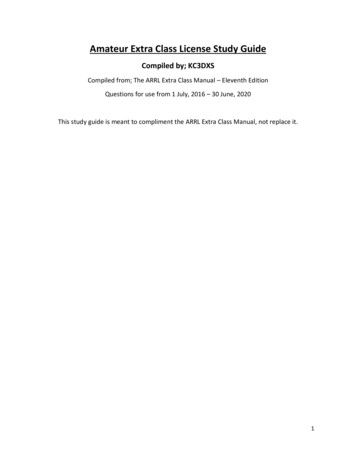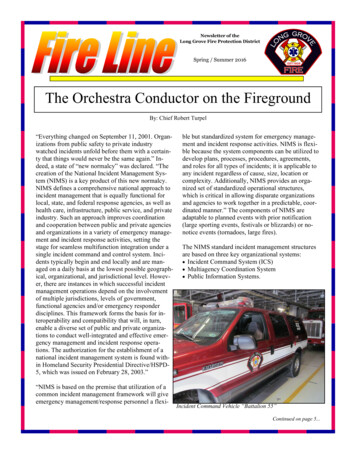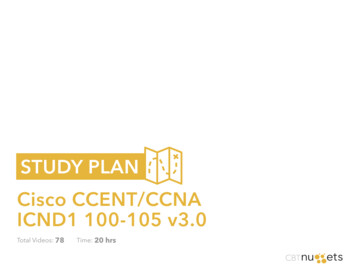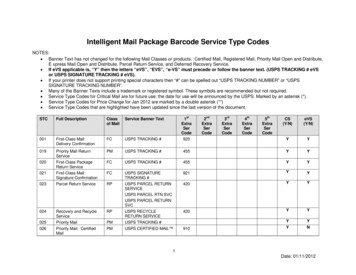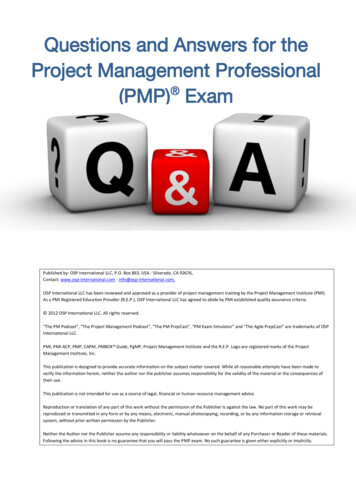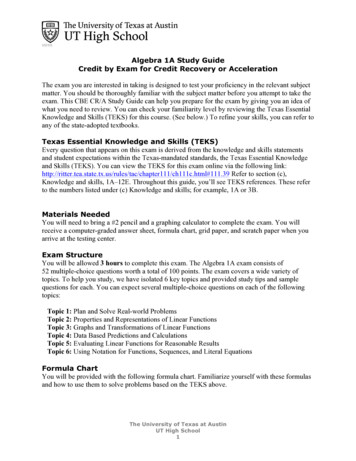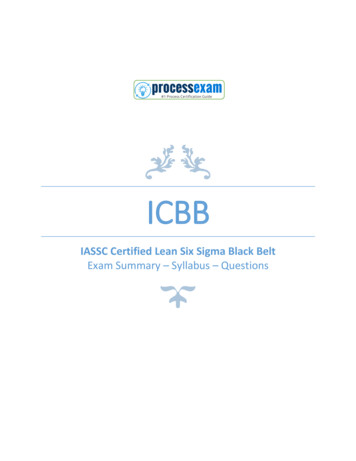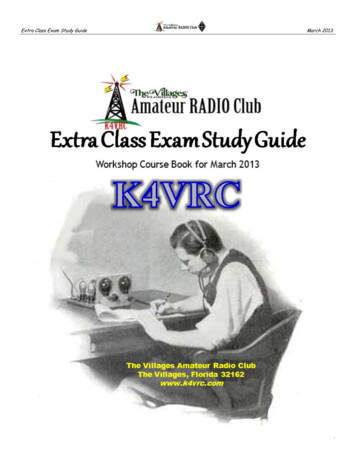
Transcription
Extra Class Exam Study GuideMarch 2013Page 1
Extra Class Exam Study GuideMarch 2013IntroductionAmateur radio has been around for a long time and has grown itself into a worldwide community oflicensed hams on the airwaves with all sorts of communications technology. Ham radio attractsthose who have never held a microphone as well as deep technical experts who grew up with asoldering iron and computer. Your United States Amateur Service license gives you the mostpowerful wireless communications capability available to any private citizen anywhere in the world.In the United States, amateur radio licensing is governed by the Federal CommunicationsCommission (FCC) under strict federal regulations. Licenses to operate amateur stations forpersonal use are granted to individuals of any age once they demonstrate an understanding of bothpertinent FCC regulations and knowledge of radio station operation and safety considerations.December 2012 marked one hundred years of amateur radio operator and station licensing by theUnited States government. Operator licenses are divided into different classes, each of whichcorrelates to an increasing degree of knowledge and corresponding privileges. Over the years, thedetails of the classes have changed significantly, leading to the current system of three openclasses and two grandfathered but closed to new applicants. The top US license class is AmateurExtra Class. The Extra Class license requires an applicant pass 35 of a 50 question multiple-choicetheory exam. Those with Amateur Extra licenses are granted all privileges on all US amateurbands.The ARRL Extra Class License description says it best; “General licensees may upgrade to ExtraClass by passing a 50-question multiple-choice examination. No Morse code test is required.In addition to some of the more obscure regulations, the test covers specialized operatingpractices, advanced electronics theory and radio equipment design. Non-licensed individualsmust pass Element 2, Element 3 and Element 4 written exams to earn an Extra License. TheFCC grants exam element 3 credit to individuals that previously held certain older types oflicenses. The HF bands can be awfully crowded, particularly at the top of the solar cycle.Once one earns HF privileges, one may quickly yearn for more room. The Extra Class license isthe answer. Extra Class licensees are authorized to operate on all frequencies allocated tothe Amateur Service.”The Extra Class workshop must cover a vast amount of material in six classes. This workshop willbe conducted as peers sitting around a table discussing a technical topic. This is the formatrequested as specific technical topics not a rote review of the questions. The material in this studyguide is formatted as abbreviated points or a quick reference format instead of slides. It is intendedthat the guide combined with the reference material supplied will have long-term value.The workshop is specially presented for those with amateur radio experience who want to learnmore. The workshop will primarily focus on technical aspects of the exam and regulatory questionsare expected to be self-study. This is intended to help members advance in the hobby we love andgive a little boost to those on the fence.Looking forward to congratulating you in your advancement to Amateur Extra Class,RickWD4JJIRichard SilverstonPresidentThe Villages Amateur Radio ClubPage 2
Extra Class Exam Study GuideMarch 2013How to best use this guideThis study guide is written to help you understand the radio theory with a practical slant, notjust teach the answers, although the scope is limited to question pool topics due to the limitedworkshop time. This guide presents and explains the Extra Class License Exam questions bydiscussing each sub-group as an individual topic. There are fifty-four topics in this guidewhich represent approximately one for each of the fifty exam questions. This study guide isnot intended to circumvent reading the assigned ARRL textbook chapter(s) but to support abetter understanding of the radio theory.Start by reading the next few pages to be sure you have all your supplies and look at thesummary of the math required during the exam. This will give you time to order materialwithout the last minute rush.Everything is provided as a PDF format for your use. Determine how you want to read yourpersonal copy of this guide and supporting material. In today’s world an electronic readermay be the right choice or if you prefer paper you can print out the workshop material andplace it in a three-ring binder. Do not wait until the weekend prior to the workshop to prepare.Read the ARRL textbook completely before the workshops. You will not understandeverything but it will help put everything into perspective during the workshops.Take online practice tests prior to the workshops but don’t worry about the score yet.Online Practice ://kb0mga.net/exams/www.radioexam.orgA few days before each workshop read the ARRL textbook chapter(s) assigned and work theproblems. It is a good idea to work your problems in a notebook and bring it to class for yourreference and help finding where that decimal point got lost.Review the exam question group(s) assigned in this study guide to help focus on the keytakeaways and scribble down questions to ask during the workshop.Again, take the online practice tests and review the questions you failed in your ARRLtextbook and this guide.If you are still having trouble, review the technical references on the workshop CD ROM.These documents have much more detail and are explained in different ways from the book.You will find over a hundred technical references on the workshop CD ROM and you are notexpected to have time to read all of them. The references are arranged by Question PoolGroup Number; E0, E1, E2 E9 followed by a subject title and number (i.e.1,2,3). Start withtitle #1 and progress to the higher numbers as they increase in detail. If you have questionsabout decibels or just want more information read “E9-dB-1” before “E9-dB-2”.If you still are having difficulties with a question(s), the workshop discussion should clarify theproblem. Do NOT be self-conscious if you are having trouble understanding; it is very likelythe rest of the workshop is also not sure.This will be a discussion group format so every workshop is intended to address yourquestions even if they are not part of assignment, just be considerate of the workshop’slimited time.The last workshop will be devoted to topic(s) as requested.Page 3
Extra Class Exam Study GuideMarch 2013Supplies you will needARRL Tenth Edition of the Extra Class License ManualARRL Extra Class License Manual 10th Edition ISBN: 978-0-87259-517-0for use July 1, 2012 to June 30, 2016Available from ARRL, book stores or ham radio retailersPencil/pen and note pad to take notes and work out problemsThe workshop CD-ROMYou will need access to a home computer to read the documents onthe workshop CD-ROM and to take practice exams.Scientific Calculator with the following functions; Add Subtract Divide Multiple Squares Square Roots Sine Cosine Arctan or tan-1 (Inverse Tangent) Base Ten Logarithms (10 x)The formal test will require you to clear your memory so purchase a calculator with little or no memory.You want to use the same calculator during home study, practice tests, workshop exercises and the realtest. Many points are lost to math errors so you want a calculator that you can operate with confidence.Page 4
Extra Class Exam Study GuideMarch 2013Math you will need to useCalculationsAdd, Subtract, Divide & MultipleSquares & Square RootsSine & CosineArctan or tan-1 (Inverse Tangent)Base Ten Logarithms (10 x)The workshop and license exam requires you to use a small amount of algebra and trigonometry to solveproblems. Every equation you need to use is listed below. Working solving the example problems will help you beat ease with using the math. If you would like to learn a bit about trigonometry, or brush up on it, then you can butdo not lose focus on the radio theory. These equations are more of an introduction and guide and the actual examquestion calculations will be shown step by step during the workshop. For more help you should read the mathreference material on your CD-ROM.ConversionsdB to ratio ratio 10 (dB/10) Solve for 5.2 dB ? 10 (5.2dB / 10) 10 0.52 3.3110dB 1 3 dB 1.995 6 dB 3.981 9dB 7.943 12dB 15.849ratio to dB dB 10 x log ( ratio/10 ) Solve for 800 ? 10 x log (800) 10 X 2.9031 29.031dB2 3dB 75 18.75dB 500 26.99dB 1500 31.76dBInductor Impedance Ω 2 π FL 2 x π x MHz x uHSolve for 18 uH @ 3.505 MHz ? 3.505 x 18 396.41 ΩCapacitor Impedance Ω 1/ (2 π FC) 1/ (2 x π x MHz x uF)Solve for 38 pF @ 14 MHz ? 1 / (2 x 3.14 x 14 x 0.000038) 1 / 0.00334096 299.32 ΩSeries RLC Impedance Freq 1/[2π (LC)] Note the R drops out!Solve for 40 pF 50 uH 22 Ω ? 1/[6.28x (0.00005x0.00000000004)] 1/(2.808501379739736e-7) 3560618 Hz 3.56 MHzParallel RLC Impedance Freq 1/[2π (LC)] Note the R drops out and use same equation for resonance!Solve for 10 pF 25 uH 47 Ω ? 1/[6.28x (0.000025x0.00000000001)] 1/(9.929551852911e-8) 10.070948 MHzRC Time Constant TC (sec) R (MΩ) x C (uF) Solve for 440 pF 500K Ω ? 0.5 x 440 220 SecondsPolar to Rectangular Coordinates Magnitude at an angle or a vector X M x Cos ϑ and Y M x Sin ϑSolve for 200 at 30 X 200 x Cos 30 173.20Y 200 x Sin 30 100Rectangular to Polar Coordinates Magnitude [X Y ] and the angle tan -1 [Y / X]Solve for X 400 and Y 3002 2M [400 300 ] 250,000 500ϑ tan -1 [300/400] tan -1 (0.75) 36.87 22Page 5
Extra Class Exam Study GuideMarch 2013TVARC 2013 Workshop Meeting ScheduleClass DateARRLChapQuestion Pool Group rev Dec 18, 2012E1Self StudySelf StudySelf StudySelf StudySelf StudySelf Study333333E1AE1BE1CE1DE1EE1FE5Mon 3/4Mon 3/4Mon 3/4Mon 3/44444E5AE5BE5CE5DE6Wed 3/6Wed 3/6Wed 3/6Wed 3/6Wed 3/6Wed 3/65554,55,65E6AE6BE6CE6DE6EE6FE7Mon 3/11Mon 3/11Mon 3/11Mon 3/11Mon 3/11Mon 3/11Mon 3/11Mon 3/1156666566E7AE7BE7CE7DE7EE7FE7GE7HE8Wed 3/13Wed 3/13Wed 3/13Wed 3/137,8787E8AE8BE8CE8DCOMMISSION’S RULESOperating StandardsStation restrictions & special operationsStation controlAmateur Satellite serviceVolunteer examiner programMiscELECTRICAL PRINCIPLESResonance & Q: resonant circuitsTime constants & phase relationshipsImpedance plots & coordinate systemsAC & RF in real circuitsCIRCUIT COMPONENTSSemiconductorsSemiconductor diodesIntegrated circuitsOptical & ToroidsPiezoelectric crystals & MMICsOpticalPRACTICAL CIRCUITSDigital circuitsAmplifiers ClassesFilters & impedance matching networksPower supplies & voltage regulatorsModulation & demodulationFrequency markers & countersActive filters & op-ampsOscillators & signal sourcesSIGNALS & EMISSIONSAC waveformsModulation & demodulation methodsDigital signals: digital modesWaves, measurements, RF groundingPage 6
Extra Class Exam Study GuideMarch 2013TVARC 2013 Workshop Meeting ScheduleClass DateARRLChapQuestion Pool Group rev Dec 18, 2012E2Wed 3/13Wed 3/13Wed 3/13Wed 3/13Wed 3/132822&88E2AE2BE2CE2DE2EE4Mon 3/18Mon 3/18Mon 3/18Mon 3/18Mon 3/187,8,97&987&87E4AE4BE4CE4DE4EE9Wed 3/20Wed 3/20Wed 3/20Wed 3/20Wed 3/20Wed 3/20Wed 3/20Wed 3/20Wed 3/20Self StudySelf StudySelf StudySelf PERATING PROCEDURESAmateur radio in spaceTelevision practicesDX; spread-spectrum; Operating FrequencyVHF and UHF digital modes; APRSHF digital modesAMATEUR PRACTICESTest equipmentMeasurement limitationsPhase noise, image rejection, S/NDynamic range, IMD, 3rd order interceptNoise suppressionANTENNAS & TRANSMISSION LINESIsotropic & gain antennasAntenna patternsWire & phased antennasDirectional antennasMatchingTransmission linesSmith ChartsEffective radiated powerRadio Direction Finding AntennasE3RADIO WAVE PROPAGATIONE3AE3BE3CEarth-Moon-Earth, meteor scatterLong path; gray-line; multi-path propagationAurora, fading; radio horizon; take-off angleE0SAFETYE0AAmateur radio safety practicesMon 3/25Topic(s) determined by class requestsWed 3/27VEC Testing all LevelsPage 7
Extra Class Exam Study GuideMarch 2013Table of ContentsINTRODUCTION . 2HOW TO BEST USE THIS GUIDE . 3SUPPLIES YOU WILL NEED . 4MATH YOU WILL NEED TO USE . 5TVARC 2013 WORKSHOP MEETING SCHEDULE . 6SUBELEMENT E0 – SAFETY - [1 exam question -– 1 group]E0A Safety: amateur radio safety practices; RF radiation hazards; hazardous materials . 10SUBELEMENT E1 - COMMISSION’S RULES [6 Exam Questions - 6 Groups]E1A Operating Standards . 15E1B Station restrictions and special operations . 17E1C Station control . 21E1D Amateur Satellite service . 22E1E Volunteer examiner program. 24E1F Miscellaneous rules . 25SUBELEMENT E2 - OPERATING PROCEDURES [5 Exam Questions - 5 Groups]E2A Amateur radio in space . 27E2B Television practices . 29E2C Contest and DX operating; spread-spectrum transmissions; selecting an operating frequency . 31E2D Operating methods: VHF and UHF digital modes; APRS . 32E2E Operating methods: operating HF digital modes; error correction . 33SUBELEMENT E3 - RADIO WAVE PROPAGATION [3 Exam Questions - 3 Groups]E3A Propagation and technique, Earth-Moon-Earth communications; meteor scatter . 34E3B Propagation and technique, trans-equatorial; long path; gray-line; multi-path propagation . 35E3C Propagation and technique, Aurora propagation; selective fading; radio-path horizon; take-off. 37SUBELEMENT E4 - AMATEUR PRACTICES [5 Exam Questions - 5 Groups]E4A Test equipment: analog & digital instruments; spectrum,network analyzers, antenna analyzers . 39E4B Measurement technique and limitations: instrument accuracy and performance limitations . 41E4C Receiver, phase noise, capture effect, noise floor, image rejection, MDS . 43E4D Receiver, blocking dynamic range, intermodulation and cross-modulation; 3rd order intercept. 46E4E Noise suppression: system noise; electrical appliance noise; line noise; locating noise sources . 48SUBELEMENT E5 - ELECTRICAL PRINCIPLES [4 Exam Questions - 4 Groups]E5A Resonance and Q: characteristics of resonant circuits: series and parallel resonance . 49E5B Time constants and phase relationships: RLC time constants: definition . 51E5C Impedance plots and coordinate systems: polar coordinates; rectangular coordinates . 53E5D AC and RF energy in real circuits: skin effect; electrostatic and electromagnetic fields . 57SUBELEMENT E6 - CIRCUIT COMPONENTS [6 Exam Questions - 6 Groups]E6A Semiconductor materials and devices: germanium, silicon: NPN, PNP, field-effect transistors . 59E6B Semiconductor diodes . 61E6C Integrated circuits: TTL digital integrated circuits; CMOS digital integrated circuits; gates. 63E6D Optical devices and toroids: cathode-ray tube devices; CCDs; LCDs; toroids: permeability . 64E6E Piezoelectric crystals and MMICs: crystals; crystal oscillators & filters; monolithic amplifiers. 66E6F Optical components and power systems: photovoltaic, optical couplers, sensors, optoisolators. 68Page 8
Extra Class Exam Study GuideMarch 2013Table of ContentsSUBELEMENT E7 - PRACTICAL CIRCUITS [8 Exam Questions - 8 Groups]E7A Digital circuits: classes of logic elements; negative logic; frequency dividers; truth tables . 69E7B Amplifiers: Class; tubes; distortion, intermodulation; spurious, parasitic; microwave amplifiers. 71E7C Filters and matching networks; filter applications; impedance matching; DSP filtering. 73E7D Power supplies and voltage regulators . 75E7E Modulation and demodulation: reactance, phase and balanced; detectors; mixer; DSP , SDR . 77E7F Frequency markers and counters: divider circuits; generators; frequency counters . 79E7G Active filters and op-amps: active audio filters; basic circuit design; operational amplifiers . 80E7H Oscillators and signal sources: oscillators; phase-locked loops; direct digital synthesizers . 82SUBELEMENT E8 - SIGNALS AND EMISSIONS [4 Exam Questions - 4 Groups]E8A AC waveforms: sine, square, sawtooth and irregular waveforms. 84E8B Modulation methods; modulation index and deviation ratio; pulse modulation; FDMA,TDMA . 86E8C Digital signals: digital communications modes; CW; data rate vs. bandwidth; spread-spectrum . 88E8D Waves, measurements, and RF grounding: peak-to-peak values, polarization; RF grounding . 90SUBELEMENT E9 - ANTENNAS AND TRANSMISSION LINES [8 Exam Questions - 8 Groups]E9A Isotropic and gain antennas; radiation pattern; resistance and reactance, gain, BW, efficiency . 92E9B Antenna patterns: E and H plane patterns; gain as a function of pattern; Yagi antennas . 94E9C Wire and phased vertical antennas: beverage; rhombic antennas; ground . 95E9D Directional antennas: gain; satellite antennas; beamwidth; SWR bandwidth; efficiency . 97E9E Matching: matching antennas to feed lines; power dividers . 99E9F Transmission lines: open and shorted feed lines: coax versus open-wire; velocity factor . 101E9G Smith chart . 102E9H Effective radiated power; system gains and losses; radio direction finding antennas . 104INDEX . 107Page 9
Extra Class Exam Study GuideMarch 2013E0ASafetyChapters 11 of ARRL Extra Class License ManualEstimated 1 Exam QuestionRadioactive materials emit ionizing radiation, while RF signals have less energy and can only causeheatingRF exposure levels at your station at a neighbor’s home must be less than the uncontrolled MPElimitsUsing an antenna modeling program to calculate field strength is a practical way to estimate whetherthe RF fields produced by an amateur radio station are within permissible MPE limitsPage 10
Extra Class Exam Study GuideMarch 2013Every transmitter that produces 5% or more of its MPE exposure limit at accessible locations formultiple transmitters operating at the same time each of the operators and licensees of which transmittersare responsible for mitigating over-exposure situationsLocalized heating of the body from RF exposure in excess of the MPE limits result from using highpower UHF or microwave transmittersEditor’s note: The body heating from RF exposure is analysis below is included to show how the bodysurface is heated by RF. This means the primary RF hazard in your shack is your skin and eyes.The National Institute of Information and Communications Technology (NICT) disclosed a numerical model databaseof a whole-body Japanese pregnant woman. The database was jointly developed with Chiba University. NumericalModel Data of Pregnant Woman Disclosed for Electromagnetic Field Analysis The distribution of the SpecificAbsorption Rate (SAR) per unit mass, at the time of frontal exposure to radio waves. Frequencies: 80MHz and 2GHz.Strength: 1mW/cm2), is shown by color.SAR is the rate at which RF energy is absorbed by the bodyThe high gain antennas commonly used can result in high RF exposure levels using microwaves inthe amateur radio bandsWhy are there separate electric (E) and magnetic (H) field MPE limits?A. The body reacts to electromagnetic radiation from both the E and H fieldsB. Ground reflections and scattering make the field impedance vary with locationC. E field and H field radiation intensity peaks can occur at different locationsD. All of these choices are correctDangerous levels of carbon monoxide from an emergency generatorcan be detected with a carbon monoxide detectorBeryllium Oxide commonly used as a thermal conductor for some typesof electronic devices is extremely toxic if broken or crushed and theparticles are accidentally inhaledPolychlorinated biphenyls found in some electronic components suchas high-voltage capacitors and transformers is considered toxicPage 11
Extra Class Exam Study GuideMarch 2013Remember this question from the General License Exam?G0A03 (D) How can you determine that your station complies with FCC RF exposure regulations?A. By calculation based on FCC OET Bulletin 65B. By calculation based on computer modelingC. By measurement of field strength using calibrated equipmentD. All of these choices are correctYou will NOT see this on the Extra exam but you should have analysis on file like the one below!Page 12
Extra Class Exam Study GuideMarch 2013Page 13
Extra Class Exam Study GuideMarch 2013Page 14
Extra Class Exam Study GuideMarch 2013E1AOperating StandardsChapters 3 of ARRL Extra Class License ManualEstimated 1 Exam QuestionUpper Sideband (USB) emissions will be 3 kHz above the carrier frequencyLower Sideband (LSB) emissions will be 3 kHz below the carrier frequencyWith your transceiver displaying the carrier frequency of phone signals, you hear a DX station's CQ on14.349 MHz USB it is NOT legal to return the call using upper sideband on the same frequencyWith your transceiver displaying the carrier frequency of phone signals, you hear a DX station calling CQon 3.601 MHz LSB it is NOT legal to return the call using lower sideband on the same frequencyWith your transceiver displaying the carrier frequency of CW signals, you hear a DX station's CQ on3.500 MHz it is NOT legal to return the call using CW on the same frequency100 watts PEP effective radiated power relative to the gain of a half-wave dipole is the maximumpower output permitted on the 60 meter bandOperation is restricted to specific emission types and specific channels describes the rules foroperation on the 60 meter band60 meter band is the only amateur band where transmission on specific channels rather than a range offrequencies is permittedPage 15
Extra Class Exam Study GuideMarch 2013If a station in a message forwarding system inadvertently forwards a message that is in violation ofFCC rules, the control operator of the originating station is primarily accountable for the rules violationThe first action you should take if your digital message forwarding station inadvertently forwards acommunication that violates FCC rules is to discontinue forwarding the communication as soon asyou become aware of itOperation of an amateur station is installed aboard a ship or aircraft must be approved by the masterof the ship or the pilot in command of the aircraftA FCC-issued amateur license or a reciprocal permit for an alien amateur licensee is required whenoperating an amateur station aboard a US-registered vessel in international watersA FCC-issued amateur license or a reciprocal permit for an alien amateur licensee is required whenoperating an amateur station aboard any vessel or craft that is documented or registered in theUnited StatesPage 16
Extra Class Exam Study GuideE1BMarch 2013Station restrictions & Special operationsChapters 3 of ARRL Extra Class License ManualEstimated 1 Exam QuestionAn emission outside its necessary bandwidth that can be reduced or eliminated without affecting theinformation transmitted constitutes a spurious emissionThe mean power of any spurious emission must be at least - 43 dB relative to the mean power of thefundamental emission from a station transmitter or external RF amplifier installed after January 1, 2003,and transmitting on a frequency below 30 MHZ1.0 is the highest modulation index permitted at the highest modulation frequency for angle modulationPage 17
Extra Class Exam Study GuideMarch 2013Operating with a 2.5kHz filter, an Upper Sideband transmitter set at 1.5kHz below the center-of-channelfrequency, with a typical voice bandpass of 300Hz to 2800Hz, the signal will just barely meet therequirements of the FCC rules for the 2.8kHz channel.The 60 Met er BandOpened t o gener al and above on Jul y 1, 2003 On assigned frequencies (channels) only Maximum 2.8 KHz occupied bandwidth ( 1.4 KHz from channel freq.) Therefore must tune 1.4 KHz lower than channel frequency (USB) Upper Side Band Only Max ERP (Effective Radiated Power of 50 Watts referenced to a dipole5,332 KHZ5,348 KHZ5,368 KHZTune to 5,345.5 KHZTune to 5,330.5 KHZTune to 5,36.5 KHZ5,373 KHZ5,405 KHZTune to 5,371.5 KHZTune to 5,403.5 KHZ2.8 kHz is the maximum bandwidth for a data emission on 60 metersThe carrier frequency of a CW signal must be at the center frequency of the channel to comply withFCC rules for 60 meter operationLocations of environmental importance or significant in American history, architecture, or culture mightcause the physical location of an amateur station apparatus or antenna structure to be restrictedAn Environmental Assessment must be submitted to the FCC before placing an amateur stationwithin an officially designated wilderness area or wildlife preserve, or an area listed in the NationalRegister of Historical PlacesPage 18
Extra Class Exam Study GuideMarch 2013If you are installing an amateur station antenna at a site at or near a public use airport you may have tonotify the Federal Aviation Administration and register it with the FCC as required by Part 17 of FCCrulesFCC monitoring facility must protect that facility from harmful interference. Failure to do so could result inimposition of operating restrictions upon the amateur station by an EIC pursuant to Sec. 97.121 of thispart. Geographical coordinates of the facilities that require protection are listed in Sec. 0.121 (c) of thischapter. There are 14 such stations listed in 47 CFR 0.121(b) and are shown below.Within 1 mile an amateur station must protect an FCC monitoring facility from harmful interferencePage 19
Extra Class Exam Study GuideMarch 2013Any FCC-licensed amateur station certified by the responsible civil defense organization for the areaserved may be operated in RACESAll amateur service frequencies authorized to the control operator are authorized to an amateurstation participating in RACESAn amateur station could be required to avoid transmitting during certain hours on frequencies thatcause the interference if its signal causes interference to domestic broadcast reception, assuming that thereceiver(s) involved are of good engineering designPage 20
Extra Class Exam Study GuideMarch 2013E1CStation ControlChapters 3 of ARRL Extra Class License ManualEstimated 1 Exam QuestionThe use of devices and procedures for control so that the control operator does not have to bepresent at a control point is automatic control of a stationUnder automatic control the control operator is not required to be present at the control pointAn automatically controlled station may retransmit third party communications when transmittingRTTY or data emissionsAn automatically controlled station may NOT originate third party communications29.500 - 29.700 MHz are available for an automatically controlled repeater operationOnly auxiliary, repeater or space stations may automatically retransmit the radio signals of otheramateur stationsA control operator must be present at the control point of a remotely controlled amateur stationA station controlled indirectly through a control link is a remotely controlled station3 minutes is the maximum permissible duration of a remotely controlled station’s transmissions if itscontrol link malfunctionsDirect manipulation of the transmitter by a control operator is meant by local controlPage 21
Extra Class Exam Study GuideMarch 2013E1DAmateur Satellite ServiceChap
Extra Class Exam Study Guide March 2013 Page 2 Introduction Amateur radio has been around for a long time and has grown itself into a worldwide community of licensed hams on the airwaves with all sorts of communications technology. Ham radio attracts those who have never held a microp
